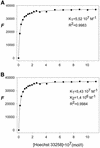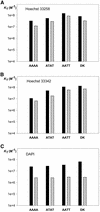Determination of affinity, stoichiometry and sequence selectivity of minor groove binder complexes with double-stranded oligodeoxynucleotides by electrospray ionization mass spectrometry
- PMID: 12177310
- PMCID: PMC134255
- DOI: 10.1093/nar/gnf081
Determination of affinity, stoichiometry and sequence selectivity of minor groove binder complexes with double-stranded oligodeoxynucleotides by electrospray ionization mass spectrometry
Abstract
Electrospray mass spectrometry was evaluated regarding the reliability of the determination of the stoichiometries and equilibrium association constants from single spectra. Complexes between minor groove binders (Hoechst 33258, Hoechst 33342, DAPI, netropsin and berenil) and 12mer oligonucleotide duplexes with a central sequence (A/T)4 flanked by G/C base pairs were chosen as model systems. To validate the electrospray ionization mass spectrometry (ESI-MS) method, comparisons were made with circular dichroism and fluorescence spectroscopy measurements. ESI-MS allowed the detection of minor (2 drug + DNA) species for Hoechst 33258, Hoechst 33342, DAPI and berenil with duplex d(GGGG(A/T)4GGGG). d(CCCC(A/T)4CCCC), which were undetectable with the other techniques. Assuming that the duplexes and the complexes have the same electrospray response factors, the equilbrium association constants of the 1:1 and 2:1 complexes were determined by ESI-MS, and the values show a good quantitative agreement with fluorescence determined constants for Hoechst 33258 and Hoechst 33342. It is also shown that ESI-MS can quickly give reliable information on the A/T sequence selectivity of a drug: the signal of a complex is directly related to the affinity of the drug for that particular duplex. The potential of ESI-MS as a qualitative and quantitative affinity screening method is emphasized.
Figures







Similar articles
-
Evaluation of electronic effect of phenyl ring substituents on the DNA minor groove binding properties of novel bis and terbenzimidazoles: synthesis and spectroscopic studies of ligand-DNA interaction.Oligonucleotides. 2009 Dec;19(4):329-40. doi: 10.1089/oli.2009.0190. Oligonucleotides. 2009. PMID: 19899952
-
Interaction between antitumor drugs and a double-stranded oligonucleotide studied by electrospray ionization mass spectrometry.J Mass Spectrom. 1999 Dec;34(12):1328-37. doi: 10.1002/(SICI)1096-9888(199912)34:12<1328::AID-JMS889>3.0.CO;2-F. J Mass Spectrom. 1999. PMID: 10587629
-
Base-sequence specificity of Hoechst 33258 and DAPI binding to five (A/T)4 DNA sites with kinetic evidence for more than one high-affinity Hoechst 33258-AATT complex.J Mol Biol. 2002 Feb 1;315(5):1049-61. doi: 10.1006/jmbi.2001.5301. J Mol Biol. 2002. PMID: 11827475
-
DNA minor-groove recognition by small molecules.Nat Prod Rep. 2001 Jun;18(3):291-309. doi: 10.1039/a705982e. Nat Prod Rep. 2001. PMID: 11476483 Review. No abstract available.
-
Nonintercalating DNA-binding ligands: specificity of the interaction and their use as tools in biophysical, biochemical and biological investigations of the genetic material.Prog Biophys Mol Biol. 1986;47(1):31-112. doi: 10.1016/0079-6107(86)90005-2. Prog Biophys Mol Biol. 1986. PMID: 2422697 Review. No abstract available.
Cited by
-
Anti-Japanese-encephalitis-viral effects of kaempferol and daidzin and their RNA-binding characteristics.PLoS One. 2012;7(1):e30259. doi: 10.1371/journal.pone.0030259. Epub 2012 Jan 20. PLoS One. 2012. PMID: 22276167 Free PMC article.
-
The 3D structures of G-quadruplexes of HIV-1 integrase inhibitors: molecular dynamics simulations in aqueous solution and in the gas phase.J Mol Model. 2010 Apr;16(4):645-57. doi: 10.1007/s00894-009-0592-0. Epub 2009 Oct 4. J Mol Model. 2010. PMID: 19802725
-
Synthesis and Biological Evaluation of Novel 1H-Benzo[d]imidazole Derivatives as Potential Anticancer Agents Targeting Human Topoisomerase I.ACS Omega. 2022 Jan 10;7(3):2861-2880. doi: 10.1021/acsomega.1c05743. eCollection 2022 Jan 25. ACS Omega. 2022. PMID: 35097282 Free PMC article.
-
Rapid characterization of cross-links, mono-adducts, and non-covalent binding of psoralens to deoxyoligonucleotides by LC-UV/ESI-MS and IRMPD mass spectrometry.Analyst. 2010 May;135(5):943-52. doi: 10.1039/b924023c. Epub 2010 Feb 12. Analyst. 2010. PMID: 20419242 Free PMC article.
-
Hydration changes accompanying the binding of minor groove ligands with DNA.Biophys J. 2007 Feb 1;92(3):959-65. doi: 10.1529/biophysj.106.097451. Epub 2006 Nov 17. Biophys J. 2007. PMID: 17114230 Free PMC article.
References
-
- Fenn J.B., Mann,M., Meng,C.K., Wong,S.F. and Whitehouse,C.M. (1989) Electrospray ionization for mass spectrometry. Science, 246, 64–71. - PubMed
-
- Fenn J.B., Mann,M., Meng,C.K. and Wong,S.F. (1990) Electrospray ionization-principles and practice. Mass Spectrom. Rev., 9, 37–70.
-
- Ganem B., Li,Y.-T. and Henion,J.D. (1991) Detection of non-covalent receptor-ligand complexes by mass spectrometry. J. Am. Chem. Soc., 113, 6294–6296.
-
- Smith D.L. and Zhang,Z. (1994) Probing non-covalent structural features of proteins by mass spectrometry. Mass Spectrom. Rev., 13, 411–429.
-
- Smith R.D., Bruce,J.E., Wu,Q. and Lei,Q.P. (1997) New mass spectrometric methods for the study of non-covalent associations of biopolymers. Chem. Soc. Rev., 26, 191–202.
Publication types
MeSH terms
Substances
LinkOut - more resources
Full Text Sources
Miscellaneous

